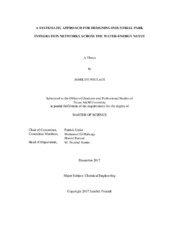| dc.contributor.advisor | Linke , Patrick | |
| dc.creator | Fouladi, Jamileh | |
| dc.date.accessioned | 2019-01-16T17:29:56Z | |
| dc.date.available | 2019-12-01T06:32:49Z | |
| dc.date.created | 2017-12 | |
| dc.date.issued | 2017-12-14 | |
| dc.date.submitted | December 2017 | |
| dc.identifier.uri | https://hdl.handle.net/1969.1/173091 | |
| dc.description.abstract | Nowadays, water-energy resource faces growing demands and constraints in many regions as a result of economic, population growth and climate change. The water-energy nexus and integration has been recently proposed to minimize water-energy footprint of an industrial park. It is required to develop a systematic approach for water-energy network and interconnections among the processes. Previous research work has presented the general superstructure and approach to develop economically optimal water networks that achieve a specified footprint target. In this work, the previous approach for water network has been extended with cooling systems options in order to capture the linkages between water and energy within industrial cities. The objective of this paper is to develop a framework for optimizing energy and water resources from processes that have a surplus of energy at various qualities. A systematic procedure is developed for optimizing and maximizing the benefits of these nexuses, considering power generation from a net surplus of waste heat energy from each plant by accounting for different sustainability metrics. The developed approach includes the use of composite curve analysis to first identify the potential for excess heat and then used to develop the combined water-energy network. A superstructure is generated to embed various configurations and related optimization formulation is solved to obtain an optimal process that economically satisfies the demand for water and energy considering some environmental metrics. Special emphasis is placed on capturing the synergy potentials from utilizing excess process heat and synergies across cooling and desalination systems, as well as synergies with the surroundings in terms of power and water exports from the industrial cluster. The work considers multiple objectives to explore trade-offs between minimum total annual cost and environmental sustainability metrics. A case study of an industrial cluster of typical processes operating in Qatar is presented to highlight the benefits of integration. It is shown how economically very attractive solutions across the nexus are identified by the proposed optimization-based approach. The results indicate that by water-energy integration the footprint reduction can be significant while economically is attractive too. Therefore, there is a great potential for savings water-energy resources by water-energy integrations. The work is contributed to sustainable development such as less pollution and resource minimization. | en |
| dc.format.mimetype | application/pdf | |
| dc.language.iso | en | |
| dc.subject | eco-industrial parks | en |
| dc.subject | water-energy nexus network | en |
| dc.subject | optimization | en |
| dc.subject | integration | en |
| dc.subject | waste heat recovery | en |
| dc.subject | sustainability | en |
| dc.title | A Systematic Approach for Designing Industrial Park Integration Networks Across the Water-Energy Nexus | en |
| dc.type | Thesis | en |
| thesis.degree.department | Chemical Engineering | en |
| thesis.degree.discipline | Chemical Engineering | en |
| thesis.degree.grantor | Texas A & M University | en |
| thesis.degree.name | Master of Science | en |
| thesis.degree.level | Masters | en |
| dc.contributor.committeeMember | El-Halwagi , Mahmoud | |
| dc.contributor.committeeMember | Parsaei, Hamid | |
| dc.type.material | text | en |
| dc.date.updated | 2019-01-16T17:29:56Z | |
| local.embargo.terms | 2019-12-01 | |
| local.etdauthor.orcid | 0000-0002-3668-2619 | |


